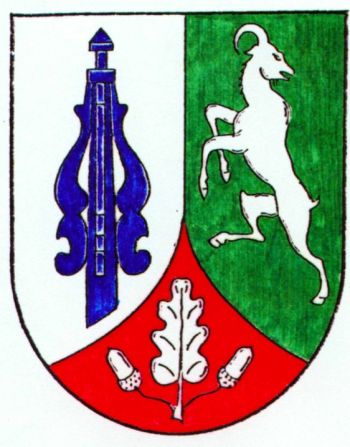Dankersen: Difference between revisions
Knorrepoes (talk | contribs) m (Text replacement - "Literature :" to "'''Literature''':") |
Knorrepoes (talk | contribs) No edit summary |
||
| Line 1: | Line 1: | ||
{{ | {| class="wikitable" | ||
|- style="vertical-align:top;" | |||
|[[File:{{PAGENAME}}.jpg|center|350 px|alt=Wappen von {{PAGENAME}}/Arms (crest) of {{PAGENAME}}]] | |||
| | |||
'''Country''' : Germany [[File:germany-flag.jpg|60 px|right]]<br><br><br> | |||
'''State''' : [[Nordrhein-Westfalen]][[File:nordrhei.jpg|60 px|right]]<br><br><br> | |||
'''District (Kreis)''' :[[Minden-Lübbecke]] (until 1973 [[Minden (kreis)|Minden]])[[File:mindenl.kreis.jpg|60 px|right]]<br><br><br><br> | |||
'''Incorporated into''':<br> | |||
* 1973 [[Minden]] | |||
{{#display_map:52.2955,8.9615|width=250|height=250|zoom=7}} | |||
|} | |||
{| class="wikitable" | {| class="wikitable" | ||
| Line 21: | Line 24: | ||
===Origin/meaning=== | ===Origin/meaning=== | ||
Dankersen has always been an agricultural village. Unlike in neighboring Niedersachsen, where the house gables were decorated with horse heads, the farmhouses in Dankersen had a gable post as a gable ornament. This peculiarity therefore appears in the arms. | Dankersen has always been an agricultural village. Unlike in neighboring Niedersachsen, where the house gables were decorated with horse heads, the farmhouses in Dankersen had a gable post as a gable ornament. This peculiarity therefore appears in the arms. | ||
| Line 28: | Line 30: | ||
The presence of the goat in the arms goes back to a story involving local pastor Albert Lortzing. During his tenure in office from 1856 to 1880, Pastor Lortzing shaped and changed the life of the citizens in a very strict way. Dance events of any kind were strictly forbidden. In the event of violations, the pastor intervened personally. Many young men did not put up with this in the long run. When Pastor Lortzing once only managed to dissolve a dance event with great difficulty, he is said to have described these men in his sermon on the following Sunday as "horny goats" (geile Böcke). This saying spread at lightning speed in the nearby towns. There the term "Geilbockshausen" was coined, which has not changed to this day as the nickname for Dankersen. | The presence of the goat in the arms goes back to a story involving local pastor Albert Lortzing. During his tenure in office from 1856 to 1880, Pastor Lortzing shaped and changed the life of the citizens in a very strict way. Dance events of any kind were strictly forbidden. In the event of violations, the pastor intervened personally. Many young men did not put up with this in the long run. When Pastor Lortzing once only managed to dissolve a dance event with great difficulty, he is said to have described these men in his sermon on the following Sunday as "horny goats" (geile Böcke). This saying spread at lightning speed in the nearby towns. There the term "Geilbockshausen" was coined, which has not changed to this day as the nickname for Dankersen. | ||
[[Civic Heraldry Literature - Germany|'''Literature''']]: Ziegler, 1994 | [[Civic Heraldry Literature - Germany|'''Literature''']]: Ziegler, 1994 | ||
{{de1}} | |||
{{media}} | |||
[[Category:German Municipalities D]] | [[Category:German Municipalities D]] | ||
Revision as of 06:15, 11 December 2022
|
Country : Germany State : Nordrhein-Westfalen District (Kreis) :Minden-Lübbecke (until 1973 Minden) Incorporated into:
|
| German |
Über gekürzter und eingeschweifter roter Spitze mit aufrechtem silbernen Eichenblatte mit zwei silbernen Eicheln am Blattstiel, gespalten von Silber und Grün; vorne ein blauer Giebelpfahl, hinten ein steigender Ziegenbock mit nach links gewendetem Kopf. |
| English | No blazon/translation known. Please click here to send your (heraldic !) blazon or translation |
Origin/meaning
Dankersen has always been an agricultural village. Unlike in neighboring Niedersachsen, where the house gables were decorated with horse heads, the farmhouses in Dankersen had a gable post as a gable ornament. This peculiarity therefore appears in the arms.
The oak leaf stands for the Hasenkamp area. Hasenkamp was originally an independent place and was first mentioned a century earlier as Dankersen (1090). In later documents the location appears as "Hasenkamp bei Dankersen". Only very small remains of the oak forest that once surrounded the settlement have survived to this day.
The presence of the goat in the arms goes back to a story involving local pastor Albert Lortzing. During his tenure in office from 1856 to 1880, Pastor Lortzing shaped and changed the life of the citizens in a very strict way. Dance events of any kind were strictly forbidden. In the event of violations, the pastor intervened personally. Many young men did not put up with this in the long run. When Pastor Lortzing once only managed to dissolve a dance event with great difficulty, he is said to have described these men in his sermon on the following Sunday as "horny goats" (geile Böcke). This saying spread at lightning speed in the nearby towns. There the term "Geilbockshausen" was coined, which has not changed to this day as the nickname for Dankersen.
Literature: Ziegler, 1994
Contact and Support
Partners:
Your logo here ?
Contact us
© since 1995, Heraldry of the World, Ralf Hartemink 
Index of the site












